Wrist Support for Push Ups: How to Protect Your Wrists?
Author:
Reviewed by:
(21 years of Oly Lifting experience)
Unlock your full potential by engaging with our experts and community! Have questions about your fitness journey or looking for expert advice on weightlifting techniques? Don’t hesitate — leave a comment below and Ihor Shymechko will provide a personalized answer and insights to help you reach your goals.
Torokhtiy is reader-supported. Some links are affiliate links, and we may earn a commission at no extra cost to you. See our disclosure page for details.
Using wrist support for push ups is a great idea if you’re experiencing wrist pain. Whilst push-ups can be fun, wrist pain isn’t. Wrist pain is becoming a more common complaint among exercisers as push-ups become more popular.
In this case, it might be time to look at wearing a wrist guard for push ups, something I’ll discuss in the following guide.
A push-up is a simple calisthenics exercise where you raise and lower your body using your arms. It works a wide range of muscles including the chest, triceps, shoulders, and core. It’s an exercise that can be done anywhere and at any ability level.
Push-ups put a lot of pressure on your wrists when your hands are placed flat against the ground. Using wrist support for push ups can help to prevent wrist injuries by giving the wrists more stability and balance, stopping your wrist joints from overextending.
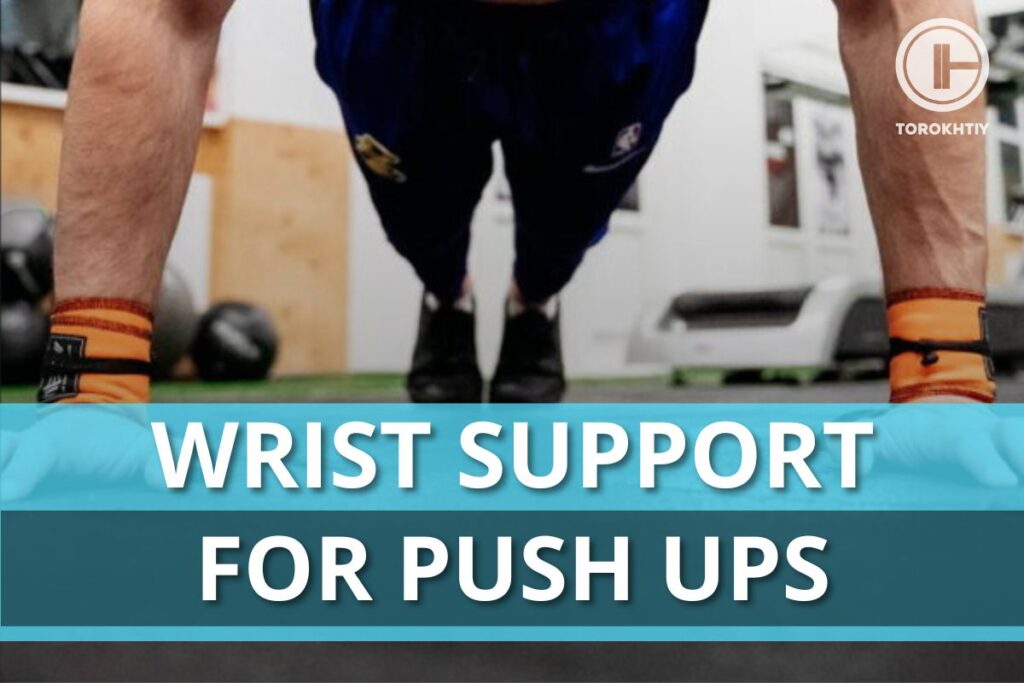
Why Do You Feel Wrist Pain During Pushups?
The push-up position puts a lot of pressure and stress on the wrist joints. The extension and compression of the wrist joints puts pressure on support structures including the bones, tendons, ligaments, and cartilage.
Here are some reasons why you might feel pain during push-ups:
1. Technique
When performing a push-up, you need to use your upper and lower body to perform the movement correctly. Alongside your upper body muscles, your hips and core are used to maintain a straight, stable body position.
If you feel your lower body touching the ground too early, it’s a sign that you’re not engaging your hips properly. Make sure to keep a straight body position whilst focusing on engaging your lower body throughout the whole movement.
Alongside not engaging your hips, flaring your elbows out when lowering your body to the floor also puts unnecessary pressure on your wrist joints. This is quite a common issue, especially for beginners who find flaring their elbows out much easier than keeping them bent back and closer to their sides.
Flaring your elbows out during a push-up can also be bad for your shoulder and elbow joints. To fix this, keep your elbows at around a 45-degree angle whilst bending them back when lowering your body to the ground.
A good way to check your form is to use a camera or ask a friend to check.
2. Warm-up
Even if your push-up form is good, you should perform a good wrist and hand warm-up before your exercise session. This allows your wrist and hands to get loose and be ready to perform push-ups alongside other gym exercises.
Rotate each finger and thumb in a circle a few times each way. Make sure you’re only moving one finger or thumb at a time. If you’re finding this difficult, it’s a sign that you need to warm up more and this could be why you’re feeling wrist pain.
3. Hand Positioning
A common cause of wrist pain during push-ups is incorrect hand positioning. Placing your wrists too far in front, too far to the side, or at the wrong angle relative to your body increases the pressure on your wrist joint. This increased pressure can cause wrist pain that won’t go away unless you fix your hand positioning.
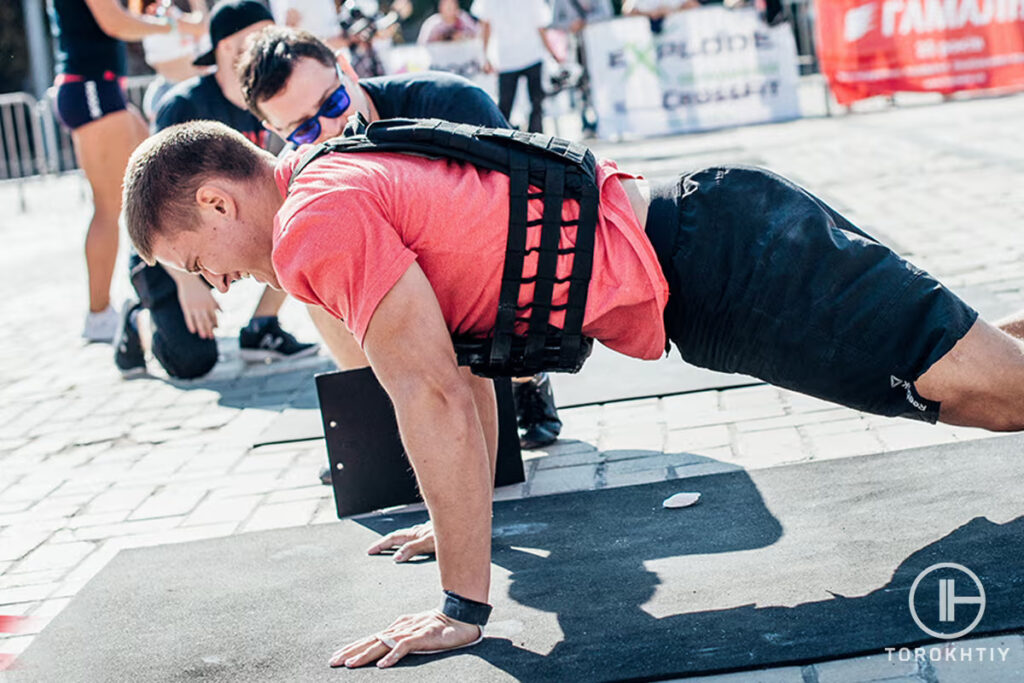
Your hands should be facing forward, with each finger and thumb firmly on the ground. Lifting your fingers up and cupping your hand both exert more pressure on your wrist joint. When your arms are extended, make sure your wrists are directly under your shoulders.
4. Use your core
To perform a push-up correctly, your core needs to be engaged throughout the whole movement. If you’re not using your core or it isn’t strong enough, you’re putting more pressure on your wrist and increasing the chance of wrist pain.
If you notice your hips sagging or your back moving when you’re lowering down to the ground, it’s a sign that you’re not engaging your core or you need to strengthen it. Before lowering down, take a breath in and try to tense your core area.
Use your abdominal muscles to pull your belly button up and in against your breath. It takes a bit of practice but you should notice a difference fairly quickly.
Simplifying your push-ups whilst performing core exercises such as planks is a good way to take a step back and limit the damage to your wrists. Start with half planks on your forearms and progress to full planks.
How to Support Your Wrists During Pushups?
Whilst wrist pain may be painful and annoying at times, it doesn’t have to stop you from doing push-ups completely. There are lots of ways you can support your wrists and stop the pain. Here is how to do push ups without hurting wrists and other joints.
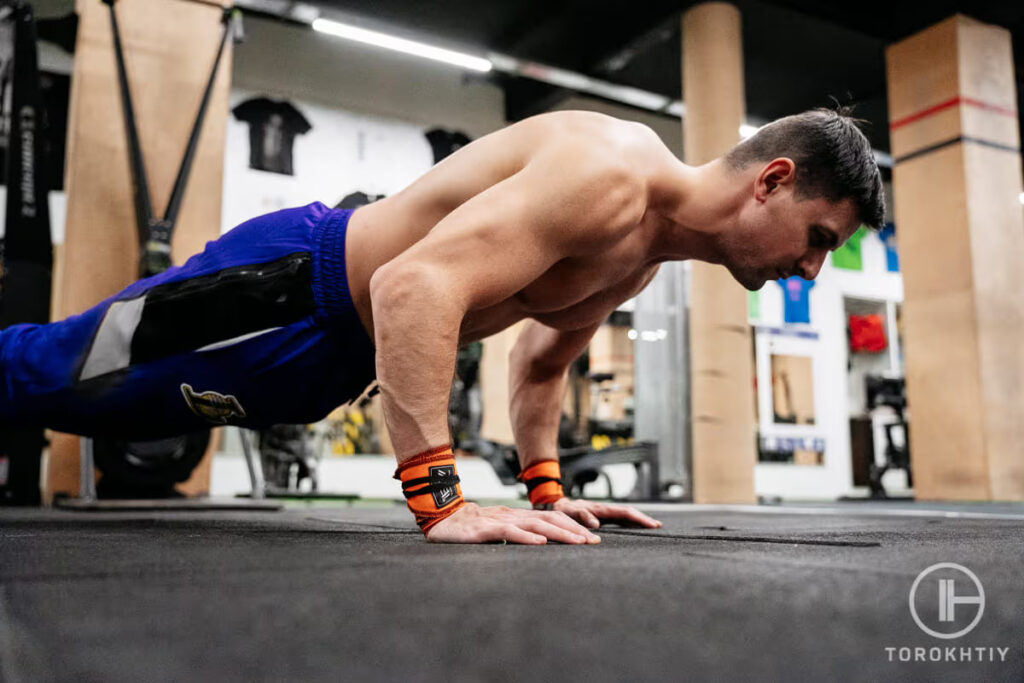
1. Use push-up bars
Using push-up bars is a great way to keep your wrists straight and take some pressure off your wrist joints. The positioning of the push-up handles relative to the floor force you to keep your wrists in a straight position rather than at awkward angles.
Performing static holds with your hands placed on the bar is a great way to practice the correct top movement and how to recruit the correct muscles before lowering your body down. You can also use dumbbells or kettlebells if you don’t have access to push-up bars.
2. Use exercises to build wrist strength
Even if you’re not experiencing wrist pain when doing push ups, performing daily stretches and strengthening exercises can increase your wrist flexibility and build strength.
The following exercises can be done at home or at the gym with little equipment and time:
1. Make a fist and hold. Open your hand and stretch your fingers as far as possible. Repeat 8-10 times with each hand.
2. Squeeze a tennis ball or equivalent ball for 10 seconds. Repeat 3 times on each hand.
3. Extend one arm out in front of you and turn your hand so your fingertips and facing down with your palms open. Using your other hand, pull your fingers and thumb down until you feel a stretch. Hold for 10 seconds and repeat 3 times for each hand.
4. Place your hands in a prayer position in the middle of your chest. Move them down until they start separating. Hold briefly and repeat 8-10 times.
3. Wrist Wraps
The health of your wrists is crucial for a wide variety of gym and everyday movements besides just push-ups. Wearing a wrist brace for push ups offers a convenient, cost-effective way to provide your wrists with the support and balance they need, keeping them strong and healthy.
They work by preventing your wrists from overextending throughout the push-up movement. They also give you time to keep strengthening your wrist and other push-up muscles whilst focusing on the correct technique.
If you’re looking for a pair of high-quality, durable wrist wraps that provide push up wrist support and come at a great price point, the WARM BODY COLD MIND Premium Velcro Weight Lifting Wrist Wraps are an excellent option.
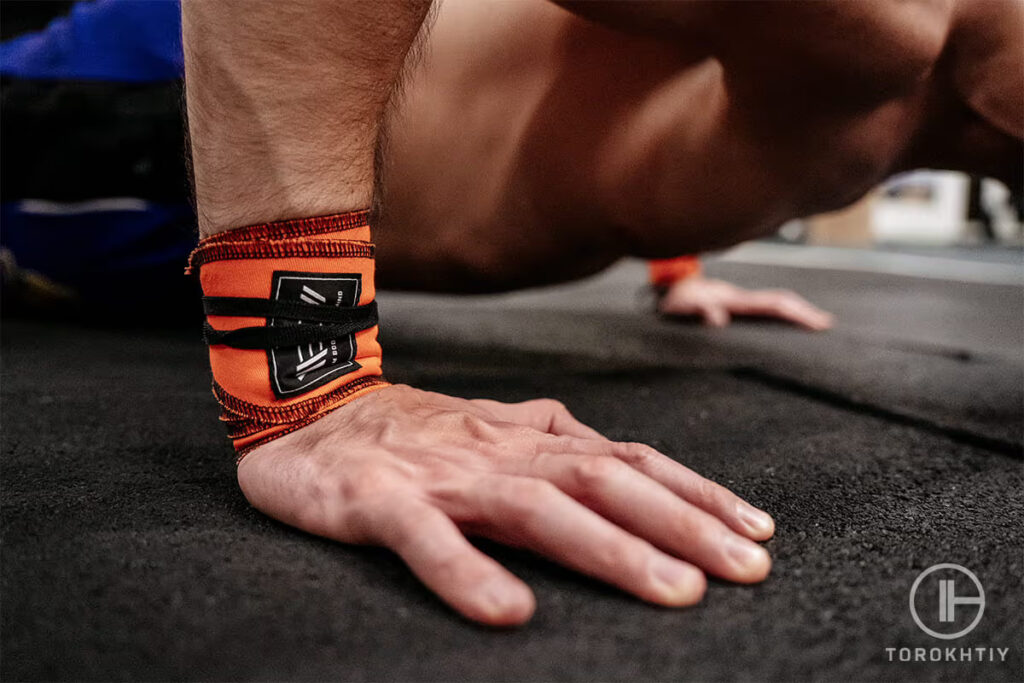
Professionally designed to offer the best wrist support for push ups, these lifting wrist wraps are suitable for a wide range of intense, dynamic exercises from weightlifting, fitness, and powerlifting, including push-ups.
The conveniently designed wrist wraps allow you to use the elastic strap and heavy-duty velcro fastener to easily slide the wraps over your wrists and securely fasten them in place. The thumb loops keep the wraps from moving and keep your wrists protected, preventing unnecessary injuries.
The quality cotton and reinforced cross stitching keep the wraps from breaking easily even with repeated, intense use.
Overall, the WARM BODY COLD MIND Premium Velcro Weight Lifting Wrist Wraps are a great, affordable option that provides you with the push-up support and confidence you need to improve your push-up technique and performance.
FAQ
Can push-ups damage wrists?
The push-up movement results in extension and compression of the wrist joint which puts a lot of strain and pressure on the wrists. Whilst this is common, long-term damage shouldn’t result if you correct what’s causing it.
Check your technique, perform regular warm-ups and wrist strengthening exercises, and use wrist support such as wrist wraps where needed.
Will wrist wraps help with push-ups?
Wrist wraps are designed to provide support and protect your wrists from injuries in movements like the push-up. By preventing your wrist joints from over-extending, they help you to focus on the correct technique cues so you don’t feel wrist pain in the future.
How do I protect my wrists when doing planks?
Before doing planks, make sure to do the wrist warm-up and strength exercises mentioned above. When doing planks, focus on the correct technique cues such as keeping your wrists, shoulders, and fingers aligned and correctly engaging your hips and core.
Using wrist support for planks will provide the extra stability and balance needed to support your wrist joints when putting them under increased pressure.
Conclusion – Do You Need Wrist Wraps for Push ups?
If you feel wrist pain when you’re doing push-ups, using wrist wraps gives your wrists the stability needed when they are under a lot of pressure during the press-up movement.
They prevent your wrists from overextending and allow you to focus on other important factors such as warming up before, using the correct technique and hand positioning, and engaging your full body throughout the movement.
Have you experienced wrist pain before? What do you think of wrist wraps? Let me know!
Also read:
- Best Wrist Wraps For Calisthenics
- Bench Press Wrist Pain
- Bench Press Wrist Position
- Ring Dips
- What Do Wrist Wraps Do
- Best Wrist Wraps For Powerlifting
References:
- How to Do Push-Ups: Proper Form, Variations, and Common Mistakes // VeryWellFit: https://www.verywellfit.com/the-push-up-exercise-3120574
- 15 Plank Variations You Haven’t Tried but Need to ASAP // HealthLine: https://www.healthline.com/health/14-plank-variations-your-core-will-thank-you-for-later#3.-Forearm-plank
- 11 Ways to Strengthen Your Wrists // HealthLine: https://www.healthline.com/health/how-to-strengthen-wrists#tips
- Photos made by Torokhtiy Media Team.
Why Trust Us?
With over 20 years in Olympic weightlifting, strength training, nutrition coaching, and general fitness our team does its best to provide the audience with ultimate support and meet the needs and requirements of advanced athletes and professional lifters, as well as people who strive to open new opportunities and develop their physical capabilities with us.
By trusting the recommendations of our certified experts in coaching, nutrition, and sports training programming, as well as scientific consultants, and physiotherapists, we provide you with thorough, well-considered, and scientifically proven content. All the information given in the articles concerning workout programming, separate exercises, and athletic performance, in general, is based on verified data.
The product testing process is described in more detail here.
Author: Ihor Shymechko
Pro Olympic Weightlifter, Coach
Best Results: Snatch – 208 kg,
C&J – 240 kg
Ihor has been a professional weightlifter since 1996, boasting over two decades of competition experience. His notable achievements include clinching the European Championship in 2009 and securing a silver medal in the 105kg division at the Senior World Championships in 2011. Ihor represented his country in the 2008, 2012, and 2016 Summer Olympics. After retiring from competitive weightlifting, he transitioned to coaching, leveraging his vast experience to guide athletes who now compete on both national and international stages.
Reviewed by: Oleksiy Torokhtiy
Olympic Weightlifting Champion
Best Results: Snatch – 200 kg,
C&J – 240 kg
Oleksiy Torokhtiy is a professional athlete boasting 20 years of experience in Olympic weightlifting. With multiple European and World titles under his belt, he has showcased his prowess in two Olympic Games (Beijing 2008 and London 2012). Upon concluding his illustrious career, Oleksiy dedicated himself to coaching. By 2022, he had conducted over 200 weightlifting seminars worldwide. He is the visionary behind an international sportswear and accessories brand known for its motto, “Warm Body Cold Mind.” Additionally, he is an esteemed author and the creator of a series of training programs and eBooks.




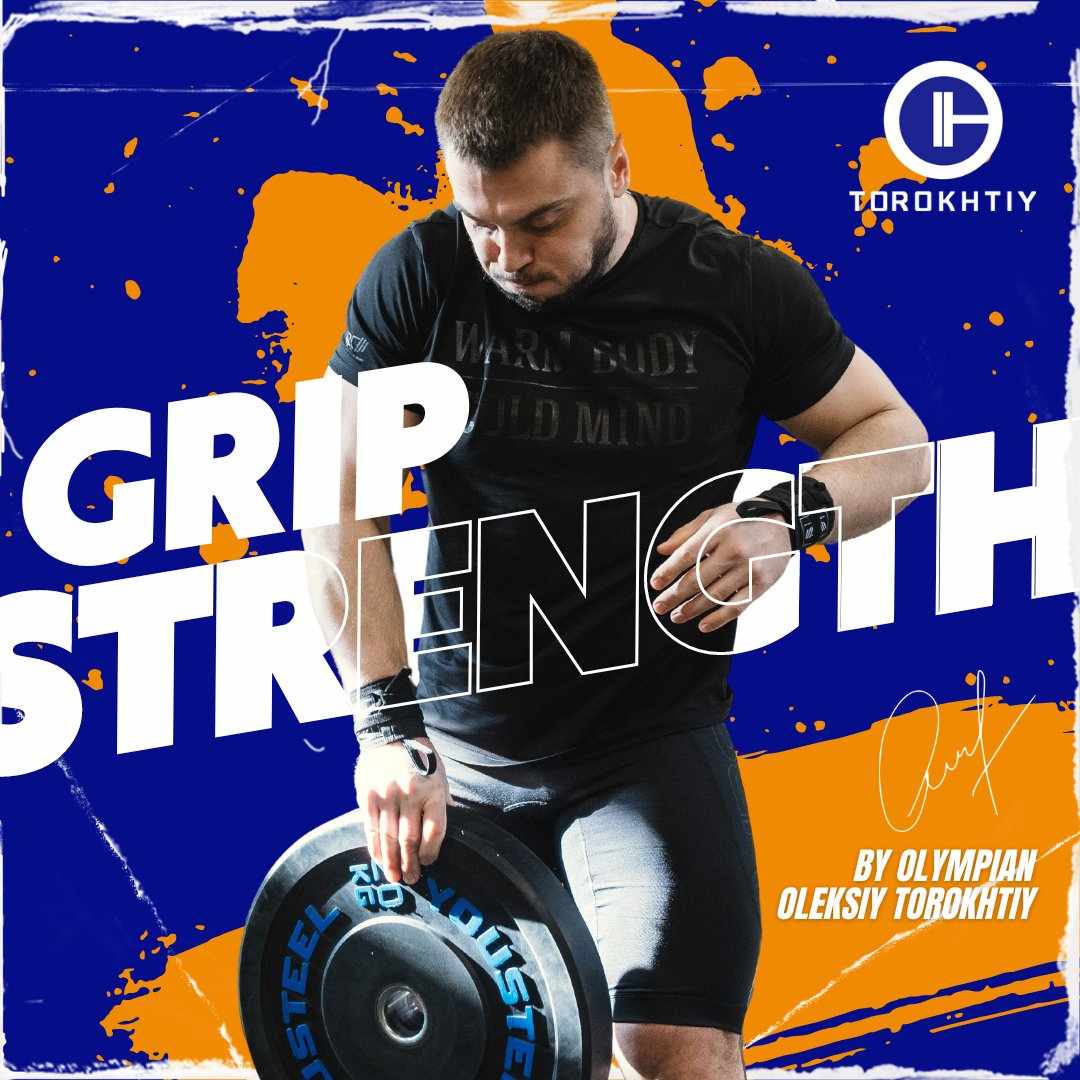
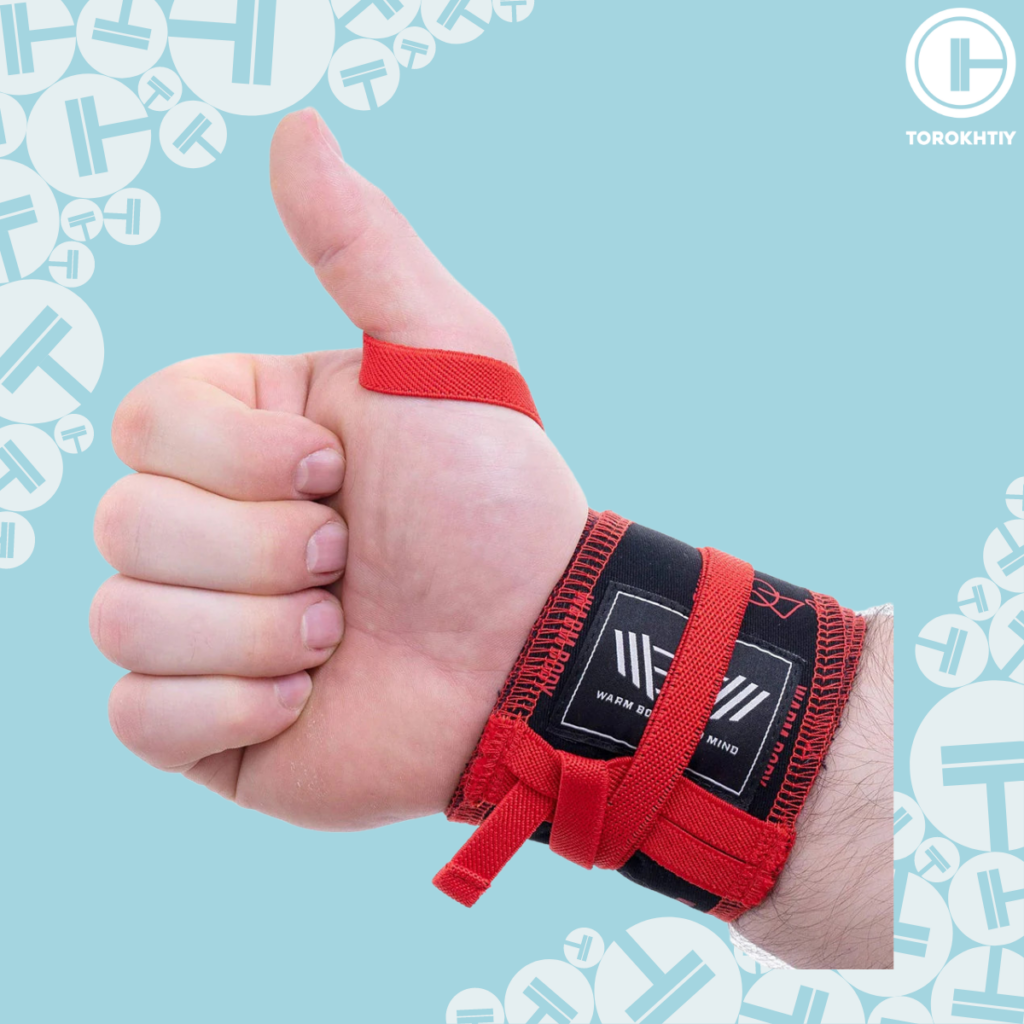
Still have questions after reading our article? Unlock your full potential by engaging with our experts and community! Don’t hesitate — leave a comment below and Ihor Shymechko will provide a personalized answer and insights to help you reach your goals.